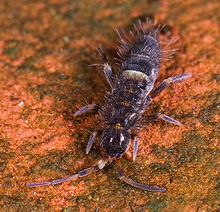
Back قافزات الذيل Arabic قافزات الذيل ARZ Collembola AST Ayaqquyruqlular Azerbaijani Нагахвосткі Byelorussian Вилоскачки Bulgarian Col·lèmbols Catalan Collembola CEB Chvostoskoci Czech Springhaler Danish
| Springtails Temporal range:
| |
|---|---|

| |
| Orchesella cincta | |
| Scientific classification | |
| Domain: | Eukaryota |
| Kingdom: | Animalia |
| Phylum: | Arthropoda |
| Clade: | Pancrustacea |
| Subphylum: | Hexapoda |
| Class: | Collembola Lubbock, 1871 |
| Orders | |
| |
| Synonyms[1] | |
| |
Springtails (class Collembola) form the largest of the three lineages of modern hexapods that are no longer considered insects. Although the three orders are sometimes grouped together in a class called Entognatha because they have internal mouthparts, they do not appear to be any more closely related to one another than they are to all insects, which have external mouthparts.
Springtails are omnivorous, free-living organisms that prefer moist conditions. They do not directly engage in the decomposition of organic matter, but contribute to it indirectly through the fragmentation of organic matter[2] and the control of soil microbial communities.[3] The word Collembola is from the ancient Greek κόλλα kólla "glue" and ἔμβολος émbolos "peg"; this name was given due to the existence of the collophore, which was previously thought to stick to surfaces to stabilize the creature.[4]
Early DNA sequence studies[5][6][7] suggested that Collembola represent a separate evolutionary line from the other Hexapoda, but others disagree;[8] this seems to be caused by widely divergent patterns of molecular evolution among the arthropods.[9] The adjustments of traditional taxonomic rank for springtails reflect the occasional incompatibility of traditional groupings with modern cladistics: when they were included with the insects, they were ranked as an order; as part of the Entognatha, they are ranked as a subclass. If they are considered a basal lineage of Hexapoda, they are elevated to full class status.
- ^ Gillott, Cedric (2005). "Apterygote hexapods". Entomology (3rd ed.). Berlin: Springer. pp. 113–125. doi:10.1007/1-4020-3183-1_5. ISBN 978-0-306-44967-3.
- ^ Brady, Nyle C. & Weil, Ray R. (2009). "Organisms and ecology of the soil". Elements of the nature and properties of soils (3rd ed.). Upper Saddle River: Prentice Hall. ISBN 978-0-13-501433-2. OCLC 276340542.
- ^ Thimm, Torsten; Hoffmann, Andrea; Borkott, Heinz; Munch, Jean Charles & Tebbe, Christoph C. (1998). "The gut of the soil microarthropod Folsomia candida (Collembola) is a frequently changeable but selective habitat and a vector for microorganisms". Applied and Environmental Microbiology. 64 (7): 2660–2669. Bibcode:1998ApEnM..64.2660T. doi:10.1128/AEM.64.7.2660-2669.1998. PMC 106441. PMID 9647845.
- ^ Lubbock, John (1873). Monograph of the Collembola and Thysanura. London: Ray Society. p. 36.
- ^ Nardi, Francesco; Spinsanti, Giacomo; Boore, Jeffrey L.; Carapelli, Antonio; Dallai, Romano; Frati, Francesco (21 March 2003). "Hexapod Origins: Monophyletic or Paraphyletic?". Science. 299 (5614): 1887–1889. Bibcode:2003Sci...299.1887N. doi:10.1126/science.1078607. PMID 12649480. S2CID 38792657.
- ^ Delsuc, Frédéric; Phillips, Matthew J.; Penny, David (12 September 2003). "Comment on 'Hexapod Origins: Monophyletic or Paraphyletic?'" (PDF). Science. 301 (5639): 1482. doi:10.1126/science.1086558. PMID 12970547. S2CID 43942720.
- ^ Nardi, Francesco; Spinsanti, Giacomo; Boore, Jeffrey L.; Carapelli, Antonio; Dallai, Romano; Frati, Francesco (12 September 2003). "Response to Comment on 'Hexapod Origins: Monophyletic or Paraphyletic?'". Science. 301 (5639): 1482. doi:10.1126/science.1087632. S2CID 82407120.
- ^ Gao, Yan; Bu, Yun; Luan, Yun-Xia (25 November 2008). "Phylogenetic Relationships of Basal Hexapods Reconstructed from Nearly Complete 18S and 28S rRNA Gene Sequences". Zoological Science. 25 (11): 1139–1145. doi:10.2108/zsj.25.1139. PMID 19267625. S2CID 10783597.
- ^ Hassanin, Alexandre (January 2006). "Phylogeny of Arthropoda inferred from mitochondrial sequences: Strategies for limiting the misleading effects of multiple changes in pattern and rates of substitution". Molecular Phylogenetics and Evolution. 38 (1): 100–116. doi:10.1016/j.ympev.2005.09.012. PMID 16290034.